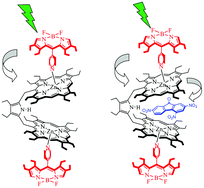We describe the synthesis, characterization and photophysical properties of the dyads Zn2DEP·TNF (1) and Zn2DEP·2Py-BDP (2) and triad Zn2DEP·2Py-BDP·TNF (3), which enable us to investigate the changes in the spectroscopic properties upon the axial coordination of pyridine substituted bodipy (Py-BDP) to Zn2DEP in the dyads and the further encapsulation of TNF in the triad. Zn2DEP·TNF (1) is structurally characterized while the other compounds, Py-BDP, 2 and 3, are geometrically optimized using DFT in the absence of X-ray crystallography. It has been found that the encapsulated TNF guest within the bisporphyrin cavity is involved in strong π–π interactions with the host resulting in robust host–guest assemblies that also retain the structural integrity in solution for a long time. The association constants, K, between the host and guests are calculated at 298 K by measuring the change in the fluorescence emission in solution and are found to be 1.0 × 107 M−2 for the 1 : 2 binding in 2 and 1.2 × 103 M−1 for the 1 : 1 binding in 3. The solution 1H NMR spectrum of the supramolecular dyad 2 shows an upfield shift of the Py-BDP protons due to the strong ring current of the porphyrin rings. Similarly, upon the encapsulation of TNF in triad 3, the guest protons undergo an upfield shift owing to the ring current effect. Electrochemical studies of dyad 2 indicate that the Py-BDP and Zn-bisporphyrin subunits in the dyads interact very weakly. The negative and positive shifts of the reduction and oxidation potentials indicate that it is difficult to reduce/oxidize the encapsulated complex 3. The steady state emission spectrum shows that the fluorescence intensity of the axially coordinated Py-BDP in 2 (excited at 500 nm) is remarkably quenched in comparison to free Py-BDP due to efficient photoinduced intramolecular singlet-to-singlet energy transfer from the excited state of Py-BDP to the zinc-bisporphyrin in 2. The remarkable quenching of the fluorescence intensity of Py-BDP upon excitation at 500 nm in 3 is due to photoinduced electron transfer from the excited states of Py-BDP to TNF, which is also thermodynamically favorable. The location of the electron densities on the HOMO and LUMO further support the formation of a charge-separated state in which the zinc-bisporphyrin acts as an electron donor whilst TNF acts as an electron acceptor in the supramolecular triad 3. The electrochemically evaluated HOMO–LUMO gap also maintains a good agreement with the computed HOMO–LUMO gap.

You have access to this article
 Please wait while we load your content...
Something went wrong. Try again?
Please wait while we load your content...
Something went wrong. Try again?


 Please wait while we load your content...
Please wait while we load your content...